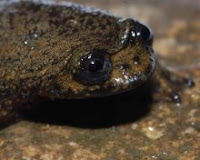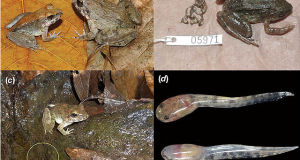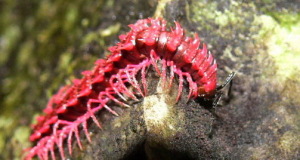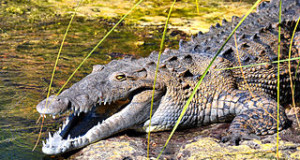Indonesia’s Kalimantan jungle toad (aka Bornean flat-headed frog), Barboula kalimantenensis, has been declared the only frog known to lack lungs. The frog itself was not collected and described until 1978. The fact that it is lung-less was released on April 10, 2008, by Dr. David Bickford of the National University of Singapore. The picture listed here is courtesy of Dr. Bickford.
This aquatic frog, known only from the Kapaus River Basin in West Kalimantan, Borneo, relies upon its skin when breathing in its habitat’s cold, highly-oxygenated waters. Its flat shape may increase the surface available for oxygen absorption, but little else is known about its natural history. Since lungs increase buoyancy, their loss may be an adaptation to life in fast-moving waters (the frog might more easily remain stable at the stream’s bottom). 
Many salamanders (i.e. North America’s red-backed salamander, Plethodon cinereus) and I species of caecilian (legless amphibians) are lung-less. Most frogs, especially aquatic species such as the African clawed frog, Xenopus laevis, a popular pet, use cutaneous respiration on occasion. Others have unusual means of assisting their lungs – the Lake Titicaca frog, Telmatobius culeus, does “push-ups” to increase water flow to its oxygen-absorbing skin folds, and male West African hairy frogs, Trichobatrachus robustus, obtain oxygen via hair-like skin projections.
Logging and mining are degrading water quality in the Kalimantan jungle toad’s streams, and threaten its continued existence.
You can read more about the frogs mentioned here at:
www.globalamphibians.org
 That Reptile Blog – Reptile, Amphibian and Exotic Pet Care and Information
That Reptile Blog – Reptile, Amphibian and Exotic Pet Care and Information




Great reading ,Thanks Frank. Alison
Thanks very much for all your interest, and for posting here, Alison. Much appreciated, Frank